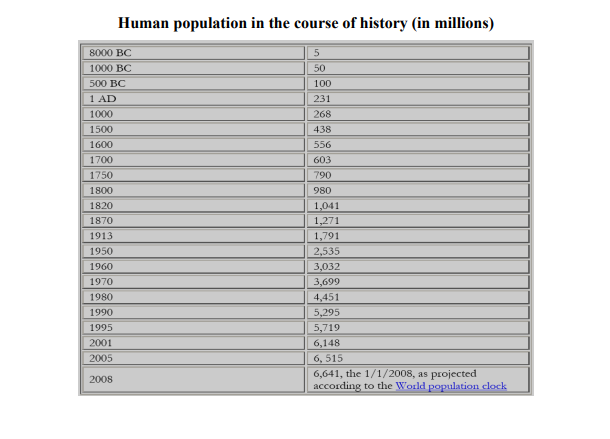Before the industrial revolution population growth was held in check by high mortality rates, which were accompanying high birth rates. The source of high mortality rates in a classical Malthusian perspective could have been the limitation in the amount of available
agricultural resources, either continuously, leading to poor nutrition (and therefore to higher morbidity and premature deaths), or episodically, through famines. But there were also other forces at play.
First of all very high rates of child mortality, either through systematic infanticide (itself probably a function of available resources), especially of females, or as a consequences of neglect and of poor living, childbearing, and childrearing conditions Second, possible neglect of the elders, the disabled and the infirm and the spread of epidemic diseases (which was favored by overcrowding and poor living conditions in the cities of agricultural societies),
Third endemic warfare, between tribes, nations or individuals, leading to direct deaths as well as to the misdirection and destruction of the resources otherwise available for survival. Still, following the improvements of agricultural technology in particular, there was some population growth at a very slow pace, slightly accelerating in time. Later on, especially since the half of the nineteenth century, the decrease in mortality rates (a true “mortality revolution” “which has resulted in doubling or more of average life expectancy at birth” and has been the direct consequence of the diffusion of medical knowledge and discoveries that has followed with some delay the Industrial Revolution) has led to a much faster population growth, while the demographic consequences of two world wars and related upheavals are shown in a temporary decrease of growth rates.
The post World War II period has seen an unprecedented population explosion, with some signs of abating however following increasing living standards and progresses in the technology of birth control, In Malthus’ own words: “The positive checks to population are extremely various, and include every cause, whether arising from vice or misery, which in any degree contributes to shorten the natural duration of human life. Under this head, therefore, may be enumerated all unwholesome occupations, severe labour and exposure to the seasons, extreme poverty, bad nursing of children, great towns, excesses of all kinds, the whole train of
common diseases and epidemics, wars, plague, and famine.”
According to Ember (1978) about 60% of the societies of hunter gatherers of which there is documentation were recorded to be at war at least once every two years. As to preindustrial civilizations it is enough to recall world and European history (for instance,
considering European history immediately preceding the Industrial Revolution, in the 16th century 95% of the time there were wars involving the major European powers, 94% in the 17th and 78% in the 18th century. The table below shows the trend in human population growth in the course of history.

